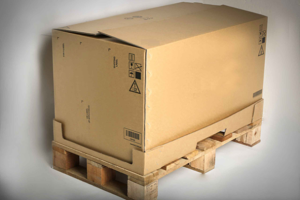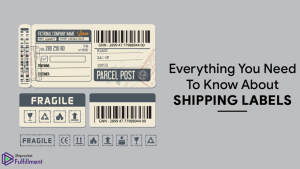As of 2022, over 12 million entities were registered under the Goods and Services Tax (GST) regime in India. This number is bound to have increased in the last 18 months, making entities engaged in the transportation of goods recognized and accounted for.
In the rapidly evolving field of logistics and supply chain management, the E-Way bill stands out as a crucial tool for tracking the movement of goods. The process of packaging and shipping goods extends beyond mere GST registration as it necessitates a parallel registration on the dedicated E-Way bill portal.

However, the process of generating an E-Way bill involves more than the necessary registration procedures involving packaging, labeling, and compliance. Apart from meeting these three stipulations, businesses must also ensure there is a secure and efficient transit of goods.
One must keep in mind transporters not registered under GST must be mandatorily enrolled on the E-Way bill portal. This ensures even non-GST registered entities are brought within the purview of the E-Way bill system, thus contributing to a more comprehensive and accountable logistics ecosystem.
The Critical Role of Proper Packaging
Beyond aesthetic considerations, packaging serves as the primary defense mechanism for goods during transit. The physical stresses and environmental factors inherent in transportation demand packaging that not only safeguards the contents but also aligns with sustainability goals. Sturdy packaging materials are essential, but corporate responsibility has brought environmental consciousness to the forefront.

According to a study conducted by Nielsen, a global measurement and data analytics company, consumers are increasingly willing to pay more for sustainable goods. The study reveals a 66% increase in global sales of sustainable goods over the past six years, indicating a significant shift in consumer preferences.
Decoding the Significance of Labels
While packaging provides physical protection, labels emerge as the informational backbone of the transportation process. The E-Way Bill System User Manual mandates meticulous recording of inspection reports, emphasizing the need for a comprehensive labeling system. Labels, often viewed as a formality, carry critical information that facilitates the seamless movement of goods and ensures compliance with regulatory standards.
The name and address of the consignor and consignee, details about the nature and quantity of the goods — these are not just pieces of information but more. They form the crux of efficient logistics management.

Clarity and legibility in labeling are non-negotiable, ensuring that the information encoded on the labels is readily accessible and accurate throughout the transportation journey.
Also Read: E-Way Bill For Job Work: Understanding The Compliance Requirements
Proactive Measures for Enhanced Compliance
With a deeper understanding of the intricacies involved, businesses can adopt proactive measures to optimize processes related to packaging and labeling for E-Way bill generation. Beyond the regulatory checklists, a comprehensive approach involves ongoing awareness, judicious material choices, precision in labeling, employee training, and regular inspections.
- Regulatory Awareness: The regulatory landscape is dynamic. Businesses need to be up to date about the regulations and standards applicable to their products. Regular updates and a proactive stance ensure ongoing compliance and adaptation to any changes.
- Employee Training: Employees should be well-versed in the regulations governing the transportation of goods. Training programs should emphasize the importance of proper packaging and labeling in ensuring compliance and efficient logistics.
- Regular Inspections: Routine inspections are a proactive measure, not just a reactive one. By conducting regular checks on packaging and labeling, businesses can ensure ongoing compliance with regulations and standards. Maintaining meticulous records of these inspections is not just a procedural requirement but a strategic move toward transparency and accountability.
Case Studies and Industry Insights
While specific case studies on businesses aligning packaging and labeling for successful E-Way bill processes may be scarce, industry insights provide a broader context.
McKinsey, a global consulting firm, offers a lens into the evolving landscape of packaging practices. In their exploration of sustainable packaging, McKinsey outlines five key levers for impact — materials, circularity, design, operations, and collaboration.
Let us understand a bit on these five key levers:
- Materials
McKinsey emphasizes the importance of the materials used in packaging. Traditionally, packaging was designed primarily for protection and convenience. However, the focus has shifted towards materials that are not only robust but also environmentally friendly. Sustainable materials, such as recycled and biodegradable options, are gaining prominence. By choosing materials with a lower environmental footprint, businesses contribute to reducing their overall impact on the planet.
- Circularity
Circularity in packaging involves designing systems where materials are continually recycled and reused. McKinsey encourages businesses to move away from linear models of production and consumption, where materials are discarded after use. Circular packaging practices aim to create closed-loop systems, minimizing waste and maximizing the utility of materials. Adopting circularity in packaging aligns with the broader goal of creating a more sustainable and resource-efficient supply chain.
- Design
Packaging design plays a pivotal role in sustainability. McKinsey underscores the significance of thoughtful design that minimizes waste and optimizes functionality. Efficient design not only reduces material usage but also enhances the overall consumer experience. By prioritizing design that considers the entire life cycle of packaging, businesses can contribute to a more sustainable and aesthetically pleasing solution.
- Operations
Operational practices have a direct impact on the environmental footprint of packaging. McKinsey recommends optimizing operations to reduce waste and energy consumption. This involves streamlining manufacturing processes, minimizing packaging waste during production, and adopting energy-efficient practices. Sustainable operations not only contribute to a company’s environmental goals but also lead to cost savings and improved efficiency.
- Collaboration
McKinsey recognizes that the journey towards impactful packaging practices requires collaboration across the supply chain. Businesses are encouraged to work closely with suppliers, manufacturers, and other stakeholders to create a cohesive approach to sustainability. Collaboration fosters innovation and the sharing of best practices, creating a collective effort towards more sustainable packaging solutions.
While McKinsey’s pillars provide a strategic framework, their real impact is observed when businesses put them into action. Companies that align their packaging practices with these pillars often witness positive outcomes, be it cost savings or enhanced brand reputation.
To cite an example, a company adopting sustainable materials not only contributes to environmental conservation but also taps into the growing market of eco-conscious consumers. Circular packaging practices can lead to a reduction in waste disposal costs and a more efficient use of resources.
The global consulting firm’s emphasis on circularity and materials underscores the need for a holistic approach. Packaging that is not only robust but also recyclable aligns with the growing demand for environmentally responsible products.
As per a Nielsen Global Corporate Sustainability Report, 81% of global consumers feel strongly that companies should help improve the environment.
Integrating Sustainability into Compliance
As businesses bring themselves towards becoming E-Way bill compliant, integrating sustainability into packaging and labeling practices emerges as a strategic imperative. While specific case studies on E-Way bill processes may be limited, the broader trend toward sustainability in packaging provides a template for forward-thinking businesses.
To conclude, E-Way bill compliance is not a singular task but a multifaceted journey that extends beyond the mere generation of a document. Proper packaging and labeling are not bureaucratic hurdles but integral components that ensure the safety of goods, regulatory compliance, and alignment with evolving consumer expectations.
The absence of specific case studies on E-Way bill processes is not a void but an opportunity for businesses to set new benchmarks. By adhering to regulations and maintaining sustainability goals, businesses can navigate the complexities of modern logistics with finesse.
The E-Way bill, far from being a regulatory constraint, then becomes a catalyst for positive change — a testament to a business’s commitment to transparency, responsibility, and operational excellence. As industries evolve and consumer preferences shift, the intersection of compliance and sustainability will become the new standard.
Businesses that embrace this intersection not only thrive in the present regulatory landscape but also future proof themselves against the dynamic currents of the global marketplace. In the world of E-Way bill compliance, the journey is as significant as the destination, and every well-packaged, properly labeled shipment is a step towards a more accountable and sustainable logistics ecosystem.
Also Read: GST: Everything You Need To Know
Frequently Asked Questions:
-
Why is E-Way bill compliance crucial in the realm of modern logistics and supply chain management?
E-Way bill compliance is crucial as it serves as a vital tool for tracking the movement of goods, ensuring comprehensive logistics management, and contributing to a more accountable ecosystem.
-
How many entities are registered under the Goods and Services Tax (GST) regime in India, and why is it important for transportation entities?
As of 2022, over 12 million entities are registered under GST in India. This registration is essential for transportation entities as it mandates enrollment on the E-Way bill portal, ensuring regulatory compliance for both GST and non-GST registered entities.
-
What role does proper packaging play in the E-Way bill process, and why is it considered a primary defense mechanism for goods during transit?
Proper packaging is a primary defense mechanism for goods during transit. It goes beyond aesthetics, safeguarding contents against physical stresses and environmental factors, ensuring both legal compliance and efficient transit.
-
According to the study by Nielsen, why is sustainability in packaging gaining prominence, and how does it impact consumer preferences?
Sustainability in packaging is gaining prominence due to a 66% increase in global sales of sustainable goods over the past six years, as per Nielsen. This shift indicates a significant change in consumer preferences, with many willing to pay more for sustainable products.
-
What information is mandated by the E-Way Bill System User Manual for labeling, and why is clarity and legibility in labeling considered non-negotiable?
The E-Way Bill System User Manual mandates details such as the name and address of the consignor, consignee, and nature/quantity of goods. Clarity and legibility are non-negotiable to ensure seamless movement, compliance with regulatory standards, and efficient logistics management.
-
What are the five key levers for impact in sustainable packaging, as outlined by McKinsey, and how do they contribute to a more environmentally responsible supply chain?
McKinsey’s five key levers for impact are materials, circularity, design, operations, and collaboration. They contribute to environmental responsibility by emphasizing the use of sustainable materials, circular packaging practices, thoughtful design, optimized operations, and collaboration across the supply chain.
-
How do businesses benefit from aligning their packaging practices with McKinsey’s pillars, and can you provide an example of positive outcomes?
Businesses benefit by witnessing positive outcomes, such as cost savings and enhanced brand reputation, when aligning with McKinsey’s pillars. For example, adopting sustainable materials taps into the growing market of eco-conscious consumers, contributing to both environmental conservation and market growth.
-
What proactive measures can businesses take to optimize processes related to packaging and labeling for E-Way bill generation, beyond regulatory checklists?
Proactive measures include regulatory awareness, judicious material choices, precision in labeling, employee training, and regular inspections. These measures go beyond checklists, ensuring ongoing compliance, a positive brand image, and efficient logistics.
-
Why is integrating sustainability into packaging and labeling practices essential for businesses becoming E-Way bill compliant, and how does it contribute to a positive brand image?
Integrating sustainability is essential as it aligns with compliance and contributes to a positive brand image. Beyond regulatory adherence, it resonates with eco-conscious consumers, reflecting a commitment to environmental responsibility and enhancing the brand’s reputation.
-
How does the absence of specific case studies on E-Way bill processes present an opportunity for businesses, and how can they set new benchmarks in compliance and sustainability?
The absence of case studies is an opportunity for businesses to set new benchmarks by innovating in compliance and sustainability. By amalgamating regulatory adherence with sustainability goals, businesses can navigate complexities and demonstrate a commitment to transparency, responsibility, and operational excellence.

